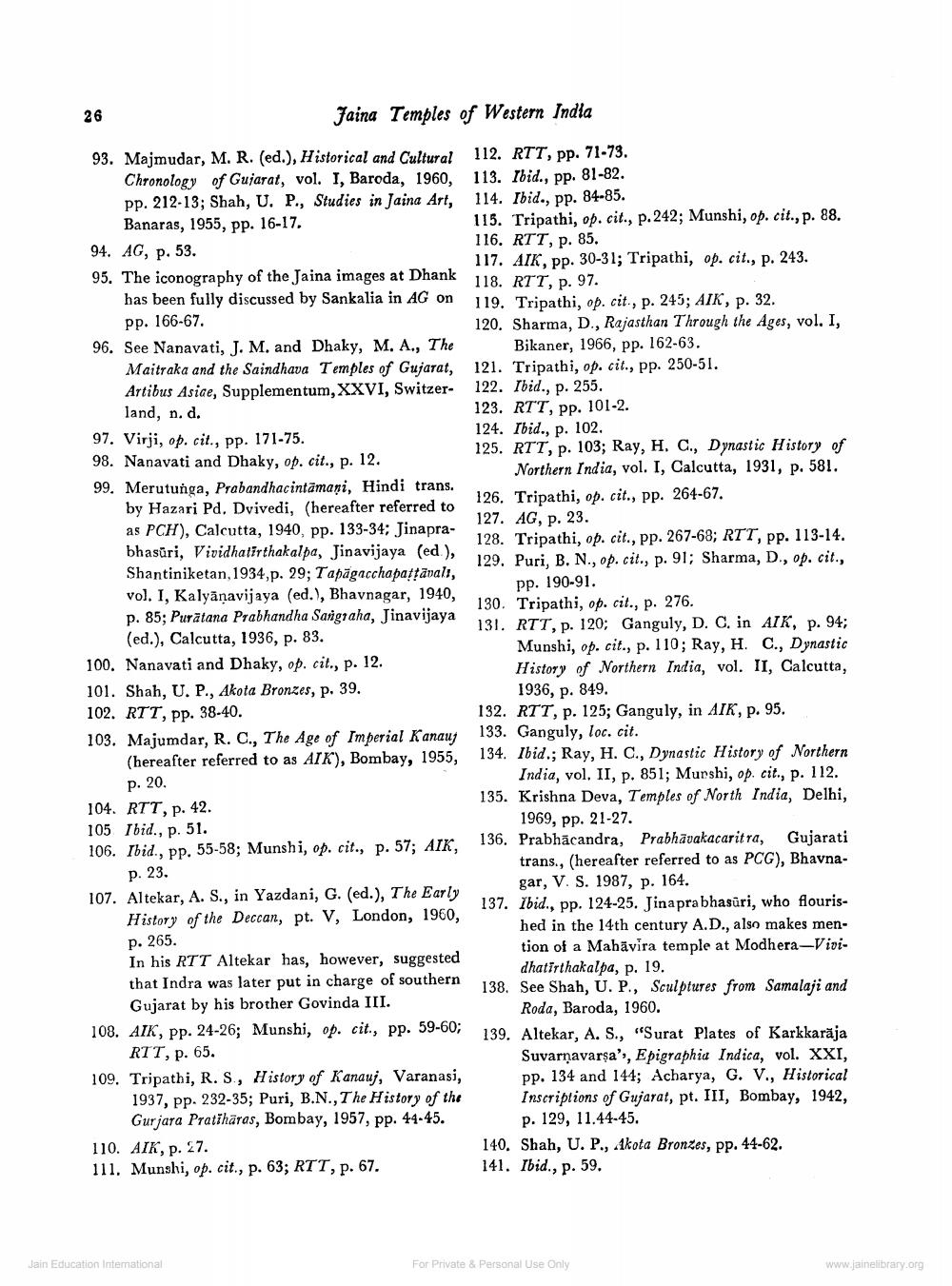________________
Jaina Temples of Western India
93. Majmudar, M. R. (ed.), Historical and Cultural
Chronology of Gujarat, vol. I, Baroda, 1960, pp. 212-13; Shah, U. P., Studies in Jaina Art,
Banaras, 1955, pp. 16-17. 94. AG, p. 53. 95. The iconography of the Jaina images at Dhank
has been fully discussed by Sankalia in AG on
pp. 166-67. 96. See Nanavati, J. M. and Dhaky, M. A., The
Maitraka and the Saindhava Temples of Gujarat, Artibus Asiae, Supplementum, XXVI, Switzer
land, n. d. 97. Virji, op. cit., pp. 171-75. 98. Nanavati and Dhaky, op. cit., p. 12. 99. Merutunga, Prabandhacintamani, Hindi trans.
by Hazari Pd. Dvivedi, (hereafter referred to as PCH), Calcutta, 1940, pp. 133-34; Jinaprabhasűri, Vividhatirthakalpa, Jinavijaya (ed.), Shantiniketan, 1934,p. 29; Tapāgacchapatļāvali, vol. 1, Kalyānavijaya (ed.), Bhavnagar, 1940, p. 85; Purātana Prabhandha Sangraha, Jinavijaya
(ed.), Calcutta, 1936, p. 83. 100. Nanavati and Dhaky, op. cit., p. 12. 101. Shah, U. P., Akota Bronzes, p. 39. 102. RTT, pp. 38-40. 103. Majumdar, R. C., The Age of Imperial Kanaut
(hereafter referred to as AIK), Bombay, 1955,
p. 20. 104. RTT, p. 42. 105 Ibid., p. 51. 106. Ibid. p. 55-58: Munshi, op. cit., p. 57: AIK.
p. 23. 107. Altekar, A. S., in Yazdani, G. (ed.), The Early
History of the Deccan, pt. V, London, 1960, p. 265. In his RTT Altekar has, however, suggested that Indra was later put in charge of southern
Gujarat by his brother Govinda III. 108. AIK, pp. 24-26; Munshi, op. cit., pp. 59-60;
RTT, p. 65. 109. Tripathi, R. S., History of Kanauj, Varanasi,
1937, pp. 232-35; Puri, B.N., The History of the
Gurjara Pratihāras, Bombay, 1957, pp. 44-45. 110. AIK, p. 27. 111. Munshi, op. cit., p. 63; RTT, p. 67.
112. RTT, pp. 71-73. 113. Ibid., pp. 81-82. 114. Ibid., pp. 84-85. 115. Tripathi, op. cit., p. 242; Munshi, op. cit., p. 88. 116. RTT, p. 85. 117. AIK, pp. 30-31; Tripathi, op. cit., p. 243. 118. RTT, p. 97. 119. Tripathi, op. cit., p. 245; AIK, p. 32. 120. Sharma, D., Rajasthan Through the Ages, vol. I,
Bikaner, 1966, pp. 162-63. 121. Tripathi, op. cit., pp. 250-51. 122. Ibid., p. 255. 123. RTT, pp. 101-2. 124. Ibid., p. 102. 125. RTT, p. 103; Ray, H, C., Dynastic History of
Northern India, vol. I, Calcutta, 1931, p. 581. 126. Tripathi, op. cit., pp. 264-67. 127. AG, p. 23. 128. Tripathi, op. cit., pp. 267-68; RTT, pp. 113-14. 129. Puri, B. N., op. cit., p. 91; Sharma, D., op. cit.,
pp. 190-91. 130. Tripathi, op. cit., p. 276. 131. RTT, p. 120; Ganguly, D. C. in AIK, p. 94;
Munshi, op. cit., p. 110; Ray, H. C., Dynastic History of Northern India, vol. II, Calcutta,
1936, p. 849. 132. RTT, p. 125; Ganguly, in AIK, p. 95. 133. Ganguly, loc. cit. 134. Ibid., Ray, H. C., Dynastic History of Northern
India, vol. II, p. 851; Munshi, op. cit., p. 112. 135. Krishna Deva, Temples of North India, Delhi,
1969, pp. 21-27. 136. Prabhācandra, Prabhāvakacaritra, Guiarati
trans., (hereafter referred to as PCG), Bhavna
gar, V. S. 1987, p. 164. 137. Ibid., pp. 124-25. Jinaprabhasūri, who flouris
hed in the 14th century A.D., also makes mention of a Mahāvira temple at Modhera-Vidi
dhatirthakalpa, p. 19. 138. See Shah, U.P., Sculptures from Samalaji and
Roda, Baroda, 1960. 139. Altekar, A. S., "Surat Plates of Karkkarāja
Suvarnavarşa', Epigraphia Indica, vol. XXI, pp. 134 and 144; Acharya, G. V., Historical Inscriptions of Gujarat, pt. III, Bombay, 1942,
p. 129, 11.44-45. 140. Shah, U. P., Akota Bronzes, pp. 44-62. 141. Ibid., p. 59.
Jain Education International
For Private & Personal use only
www.jainelibrary.org




